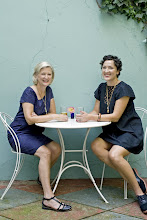
How can eco-designers stay profitable while advocating slow fashion?
It’s tough but not impossible and definitely more rewarding. The key is this, you have to be equally, if not more creative in designing your business model as your collection or product.
I have always said my biggest challenge wasn't that of being a sustainable designer, it was managing cash flow. The fashion industry, if you work within a conventional business model is a challenge, period. Seasons overlap; you are developing one season at the same time you have to pay production balances to your factories and collect from your customers for the season prior. If you don't have a nice chunk of change in your bank to self finance your development a year in advance, you are waiting for your customers to pay, which doesn't always arrive in time to pay for your production or arrive at all. This cash pickle has nothing to do with sustainable design and everything to do with the fashion calendar, credit availability, market interest rates and your retailer's financial health and/or your relationship with them.
The reality of a global economy makes sourcing "sustainable" materials and production an act of moral and financial gambling. A practice that requires an independent designer to bust out their own moral compass and make calculated and informed decisions, provide transparency and an explanation of the many gray areas to educate consumers.
Having said that, designers CAN design their own business models. Models that work better for them, the needs of the stakeholders and the development and production of their products or collections. This is where designers can really stand out, innovate and get an edge. There are pioneers doing just that, including Alabama Chanin, Tom Ford, Bonobos, Dosa and Patagonia. These are just a few examples.
I earned a degree in business before I studied fashion at CCA and I like to collect business models as a hobby. As part of this pursuit and my collective industry experience, I have compiled a list of eleven factors that I have deduced increase the likelihood of financial sustainability and the success of a business. These eleven factors are not absolutes but rather common themes I have found in brands with staying power, growing companies that are surviving the economic recession and common errors I have witnessed among new entrepreneurs.
1) Rethink success: for the past decade or more the end goal of many fashion brands was growth and often growth through a public offering. Public companies, for the sake of quick quarterly growth tend to sacrifice good design. Getting the maximum amount of goods out the door is the main objective. Often innovative, thoughtful, sustainable design requires a longer development process because it is new and requires time to problem solve and or craft. However, Private vs. Public ownership allows for more control, innovation over time, natural growth and the benefits of success returned to stakeholders rather than shareholders.
2) Triple bottom line business models focus on environmental, social and financial sustainability as opposed to conventional models that focus on growth and/or profit only. Often companies neglect to see the opportunities to provide solutions to social needs via equitable for profit business models.
3) Think vertical. Own or develop a partnership with most or the key parts of the supply chain, including, production, retail outlets, ecommerce, etc. One of the biggest challenges is getting everyone within the supply chain in sync. For example, farmers need to know market demand for organic cotton at planting time, which is typically 8 months prior to sales market for fashion. I've always believed we need a CSA (community supported agriculture) inspired system with cotton farmers. Today, with global cotton shortages it might be the only way that smaller companies can secure cotton and have it available when they need it. The largest global retailers buy up the entire supply. In addition, everyone is tightening his or her belts. Factories demand longer lead times, higher prices and larger orders. Retailers demand shorter lead times, lower prices and place smaller orders. The designer is often left in the middle with out much control and all of the risk.
4) Family funding or other equally invested/aligned partnerships are like winning the lottery. One of the biggest mistakes entrepreneurs make is going into business under-capitalized and or hastily choose partners. The healthiest companies I have seen have partners with different and complimentary strengths. There is someone who designs; another who manages the business and they share a long-term vision. You may be talented enough to do both but at a certain point there are not enough hours in the day to design and manage well. Those designers that have really won the lottery, partner with someone who is established in textiles manufacturing and/or garment manufacturing. See #2.
5) Grow your business through equity vs. debt. Some short-term debt against sales is good and necessary to leverage production but not always available and often expensive. Re-invest profits as much as you can. Taking loans out for reasons other than to pay for production based on hard orders is a high stakes gamble.
6) Don't underestimate the power of scarcity of product. If demand is greater than supply and you are still making a profit that is the good news. You’ll get there.
7) Become best friends with Quickbooks. Seriously. Know what is going on in your business, it will help you make good decisions and prevent disaster.
8) Have a genuine Story and/or "heritage". There is so much stuff out there, designers need to connect and develop relationships with customers rather than chase consumers. Customers (as opposed to consumers) bond with a brand and they come back season after season. One way to do so is to develop a unique process and tell the story about the people behind the scenes, the people making and maybe crafting your product. I think the Craftspeople, the Makers are the next “celebrities” because Americans don't know how to make anymore. The momentum is already there as seen in popular tv shows that give you a glimpse of behind the scenes production like Top Chef or Project Runway. Do not make something up, it’s not very satisfying and transparency will be asked of you.
9) Design timeless pieces and don’t reinvent the wheel every season. This not only cuts down on development costs but also makes a brand more identifiable and reliable. People fall in love with a well-designed piece, wear it beyond a season, tell their friends and come back looking for more.
10) Don’t overspend on marketing/PR expenditures. Although press can give the illusion of success there is not necessarily a direct relationship between press and sales. There are many creative ways to generate a press following but more importantly you need a customer following. Focus on making great, unique products that sell and the press will find you.
11) Live within your means, it’s much more pleasant than living in debt. Do not count the money until it is in the bank and the check has cleared, you just never know what might happen along the way.














